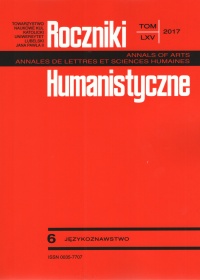The externalization of inflection in Indo-European
Abstract
The article discusses the problem of the diachronic externalization of inflection in Indo-European on the basis of (1) the externalization of the augment and (2) the externalization of the durative (nasal) morpheme. Indo-Europeanists have generally followed the traditional theory according to which the augment, i.e. the initial particle *h1e expressing past tense, represents a relatively late innovation attested in the central group of Indo-European languages. The present author demonstrates that the particle *h1e was an old morpheme originally infixed within the verbal root, e.g. PIE. *sed- ‘to sit’ (praesens) → PIE. *se-h1e-d- (praeteritum) > IE. *sēd- (past tense), cf. Lat. sedeō, perf. sēdī. The translocation of the augment from medial to initial position was probably motivated by analogy to the very frequently used verbal roots PIE. *h1es- ‘to be’, *h1ei- ‘to go’ and *h1ed- ‘to eat’, which were phonologically similar to the augment *h1e. In these roots, the original structure, namely PIE. *h1e- + (infixed augment) *h1e + -C-, was reinterpreted differently, viz. as the indeclinable augment preceding the verbal root (*h1e- + *h1eC-). By analogy, the particle *h1e started to be placed in initial position (i.e. before the verbal root) in other cases too. Intermediate (hybrid) forms of the past tense, like *h1e-me-h1e-d- (← PIE. *med-), may also be found in some Indo-European languages belonging to the central group.
The Indo-European nasal infix presents have not been explained so far from the semantic point of view. The present author proves that the infix *-n- originally expressed the feature of durativity. Due to the diachronic externalization of inflection this nasal morpheme later evolved into a suffix added to the verbal root. Verba durativa with the nasal marker -an- are attested as early as in the 2nd millennium BC in the Anatolian languages, cf. Hittite iy-ann-a/i- ‘to march, to go long’, Palaic iyannnai ‘he marches (long)’ vs. Hitt. i- ‘to go’, Luw. i-, Hier. Luw. i-, Lat. eō, īre, Lith. eĩti, OChSl. iti ‘id.’ < PIE. *h1ei- ‘to go’. The durative verbs in question, as well as the related nouns with the durative suffix *-ano-, also appear in other Indo-European languages, cf. Toch. B yaneṃ ‘they walk, go long’. Numerous Greek presents (e.g. Anc. Gk. ἁνδάνω, θιγγάνω, λαμβάνω, λανθάνω, λιμπάνω, μανθάνω, πυνθάνομαι and so on) document the same nasal morpheme not only infixed into a verbal root, but also in the form of the suffix -αν-. These verbal forms, indicating the durativity of the action, should be treated as intermediate, i.e. hybrid.
References
Beekes R. S.P.: Comparative Indo-European Linguistics. An Introduction, Amsterdam–Philadelphia: John Benjamins Publishing Company 2011.
Byrd A.M.: The Indo-European Syllable, [Brill’s Studies in Indo-European Languages & Linguistics. Vol. 15], Leiden–Boston: Brill 2015.
Chantraine P.: Grammaire homérique, t. I-II, Paris: Librairie C. Klincksieck 1958.
Comrie B.: Morphology and Word Order Reconstruction: Problems and Prospects, in: J. Fisiak (Hg.), Historical Morphology, The Hague: Mouton 1980, s. 83-96.
Danka I.R.: Stanowisko języków anatolijskich w rodzinie indoeuropejskiej i ich wzajemne związki, Łódź: Uniwersytet Łódzki 1983.
Friedrich J. [Фридрих, И.]: Краткая грамматика хеттского языка [A Concise Grammar of the Hittite Language], Москва [Moscow]: Издательство иностранной литературы 1952.
Georgiev V.I.: Introduction to the History of the Indo-European Languages, Sofia: Bulgarian Academy of Sciences 1981.
Haspelmath M.: The Diachronic Externalization of Inflection, „Linguistics” 31(1993), S. 279–309.
Ivanov V.V.: Хеттский язык [The Hittite Language], Москва: УРСС 2001.
Jasanoff J.H.: Hittite and the Indo-European Verb, Oxford: Oxford University Press 2003.
Jasanoff J.H.: Long-vowel Preterites in Indo-European, in: H.C. Melchert (Hg.), The Indo-European Verb. Proceedings of the Conference of the Society for Indo-European Studies, Los Angeles 13-15 September 2010, Wiesbaden: Dr. Ludwig Reichert Verlag 2012, S. 127-135.
Kloekhorst A.: Etymological Dictionary of the Hittite Inherited Lexicon, Leiden–Boston: Brill 2008.
Kronasser H.: Vergleichende Laut- und Formenlehre des Hethitischen, Heidelberg: Carl Winter 1956.
Majer M.: Russian kotóryj, Czech který, Slovene katę́ri: Vowel Variation in the Reflexes of Proto-Slavic *koterъ(jь) ‘which (of the two)’, „Scando-Slavica” 61(2015), Lief. 2, S. 154-179.
Melchert H.C.: Aspects of Verbal Aspect in Hittite, in: S. Alp, A. Süel (Hg.), Acts of the Third International Congress of Hittitology, Çorum, September 16-22, 1996, Ankara: Uyum Ajans 1998, S. 413-418.
Meier-Brügger M.: Indo-European Linguistics, Berlin–New York: Walter de Gruyter 2003.
Narten J.: Zum “Proterodynamischen” Wurzelpräsens, in: J. Heesterman, G. Schokker, V. Subramoniam (Hg.), Pratidānam. Studies Presented to F. B. J. Kuiper, Den Haag: Mouton de Gruyter 1968, S. 9-19.
Oettinger N.: Zu den Verben auf Vedisch -anyá- und hethitisch -anniḭe-, „Münchener Studien zur Sprachwissenschaft” 53(1992), S. 133-154.
Pike M.: The Indo-European Long-vowel Preterite: New Latin Evidence, in: J.E. Rasmussen, T. Olander, A.R. Jørgensen (Hg.), Internal Reconstruction in Indo-European: Methods, Results, and Problems. Section Papers from the XVI International Conference on Historical Linguistics, University of Copenhagen, 11th-15th August, 2003, Copenhagen: Museum Tusculanum Press 2009, S. 205-212.
Pokorny J.: Indogermanisches etymologisches Wörterbuch, Bern–München: Francke Verlag 1959.
Rikov G.T.: Sonants, Laryngeals and the Indo-European Nasal Infix Presents, „Orpheus. Journal of Indo-European and Thracian Studies” 2(1992), S. 87-96.
Rikov G.T.: Hittite (i)yanna-, Tocharian B yaneṃ and the Indo-European Nasal Infix Presents of the Type CRenhx-, „Orpheus. Journal of Indo-European and Thracian Studies” 7(1997), S. 9-36.
Rix H. (Hg.): Lexikon der indogermanischen Verben. Die Wurzeln und ihre Primärstammbildungen, Wiesbaden: Dr. Ludwig Reichert Verlag 2001.
Sandell R.: The Phonological Origins of Indo-European Long-Vowel (“Narten”) Presents, text presented at 26th Annual UCLA Indo-European Conference, Los Angeles, October 25, 2014.
Schwyzer E.: Griechische Grammatik, München: C. H. Beck’sche Verlagsbuchhandlung 1939.
Vogt H.: Grammaire de la langue géorgienne, Oslo: Universitetsforlaget 1971.
Copyright (c) 2017 Roczniki Humanistyczne

This work is licensed under a Creative Commons Attribution-NonCommercial-NoDerivatives 4.0 International License.





